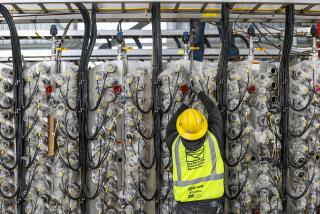Containment Plan Issued for Toxic Dump : Environment: U.S. orders four oil companies to begin work on an $80-million project designed to stabilize refineries’ aviation fuel byproducts left from World War II.
- Share via
FULLERTON — The U.S. Environmental Protection Agency on Friday revealed an $80-million remedy for the McColl toxic waste dump that calls for containing the waste on site, and ordered a coalition of oil companies to immediately begin work on the project.
The sprawling World War II-era aviation fuel dump, located in a residential section of northwest Fullerton, has languished on the federal Superfund list of the nation’s most dangerous sites for 11 years.
The federal agency’s long-awaited decision is generally endorsed by the community as well as the oil companies, so it could untangle the bureaucratic, technical and legal quagmire at McColl that has tested the patience of Fullerton residents since the late 1970s.
The EPA’s remedy for the 22-acre dump focuses entirely on containing the acidic oil waste in perpetuity instead of cleaning it up.
The top half of the waste--or as much of it as is technically feasible--will be solidified to stop tar-like material from oozing to the surface, and underground walls and a cap will be built to try to hold it all in place.
The coalition of four oil companies reacted Friday with overall support for the EPA’s order. But they are still reviewing it, and said some technical details may have to be ironed out. The companies have until next Friday to officially respond to the EPA.
Shell Oil, Texaco, Atlantic Richfield and Union Oil--which used the privately owned dump to dispose of oil refinery waste during World War II--were designated by the federal government years ago as the parties responsible for cleaning it up.
“Our first impression is we are very optimistic,” said Bill Duchie, a Shell Oil environmental manager who represents the oil coalition. “We are in the process of reviewing the details of the order, but on first blush, everything looks good. I can’t tell you that in fact we are prepared to do it all, but we are very encouraged.”
The dump, used for disposal of petroleum refinery wastes from 1942 through 1946, contains about 100,000 cubic yards of waste--the equivalent of thousands of truckloads. The highly acidic sludge contains large amounts of sulfur and cancer-causing hydrocarbons such as benzene.
The EPA order directs the oil companies to start design work immediately, and begin preliminary field work in August. They are to begin a pilot project to solidify waste in one of 12 large pits at McColl in December, and complete it by October, 1994.
If the solidification technique works in the first pit, it will be applied to the remaining 11. But if it fails, the agency will just cover all the waste with a cap and build the retaining walls.
Completing the project could take until around the year 2000.
More to Read
Sign up for Essential California
The most important California stories and recommendations in your inbox every morning.
You may occasionally receive promotional content from the Los Angeles Times.










